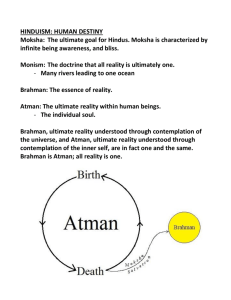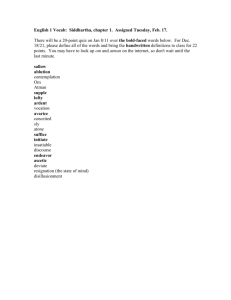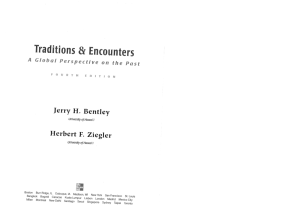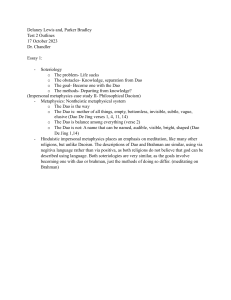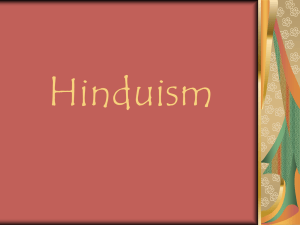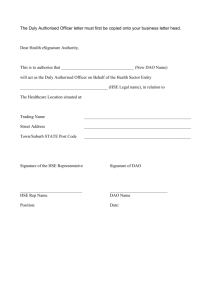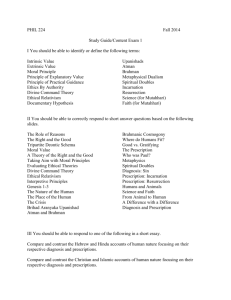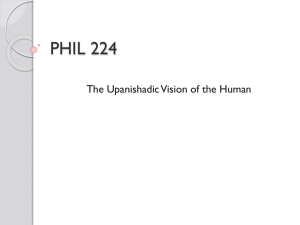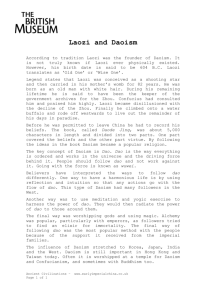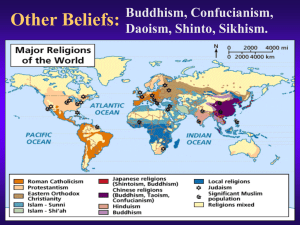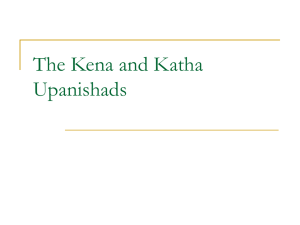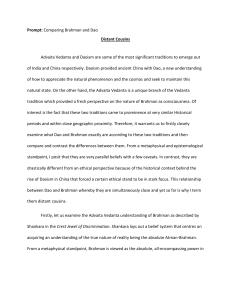Part IV: Metaphysics
advertisement
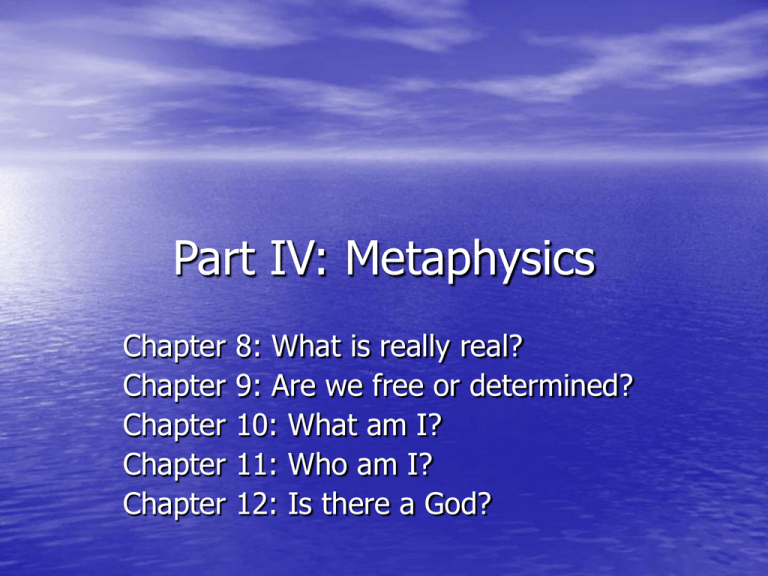
Part IV: Metaphysics Chapter Chapter Chapter Chapter Chapter 8: What is really real? 9: Are we free or determined? 10: What am I? 11: Who am I? 12: Is there a God? Chapter 8: What is Really Real? • Metaphysics has to do with the construction and criticism of theories about what is truly real • Ontology – “the study of being” • Mechanistic – the nonintentional way that material objects are causally determined Introduction • Materialism – metaphysical theory that matter is truly • • • • • real and immaterial things are not Idealism – metaphysical theory that ideas (in the sense of thoughts, concepts, and minds) are ultimately real Dualism – theory that reality is both material and immaterial Monism – In contrast to dualism, the theory that being, or reality, is fundamentally of one nature Problem of the one and the many – Debate between dualism and monism: Is there one reality, or are there many different real things that cannot be reduced to a single thing? Pluralism – position that there are many different real things The Dao • Dao – the “way of nature”, comes from the Chinese • • • • • “road” or “way”. The Dao is the source of all reality Process ontology – emphasizes change and becoming as fundamentally real Substance ontology – emphasizes permanence and unchanging being as fundamentally real De – “virtue,” “power,” or “excellence”. Laozi’s “Dao De Jing” could be translated “The book of the Way and Its Power.” Wuwei – “no action”. Refers to manner in which the Dao acts. A no-thing acts by not acting. Yin/yang – yin is for the passive or receptive force and yang is for the active and aggressive force Dao De Jing Laozi • Laozi developed the philosophy that became Daoism • The Tao is the eternal, nameless source and substance • • • • of all things Nameless = non-being Named = being Everything has an opposites that are mutual causations of each other Substance is as important as function Water is a moral symbol Dao De Jing Laozi • • • • Non-being is not nothingness but something useful There is nothing more important than the hidden Tao is revealed most fully through tranquility Taoist cosmology – in the beginning there is something undifferentiated, which is forever operating and produces heaven and earth and then all other things • Things “transform spontaneously” because the Tao takes no action and leaves things alone • The One is the original material force of the Great Ultimate • Evolution of simple to complex Platonic Dualism • Forms - Ideas characterized by permanence • Theory of Forms – matter is less real than immaterial Forms The Republic Plato • Describes good through three analogies – Analogy of the Sun: Like the sun, Good produces light by which to see and understand – Simile of the divided line: compares opinion (which comes from sensations of material objects) with knowledge (which comes from knowing the Forms via reason and understanding – Allegory of the cave: compares the philosopher to a prisoner who has escaped from a cave and seen the light of the real world Nondualism • Advalta Vedanta = nondual + end of the Vedas. – Indian philosophy advocated by Shankara. – Ultimate reality is undifferentiated unity beyond positive prediction • Brahman – ultimate reality • Atman – the true Self, the real identity behind • our individual egos Sublation – the act of correcting a previous judgment in light of a subsequent one The Crest-Jewel of Discrimination Shankara • Search for the true Self, or Atman • The Atman, which is unsublatable, is the same • • • as the Brahman, the really real Discrimination between the eternal and noneternal refers to the conviction that Brahman is real, but the universe is unreal Tranquility is detaching the mind from all objective things to direct it toward Brahman True mental poise is achieved by not letting the mind react to external stimuli The Crest-Jewel of Discrimination Shankara • Forbearance is to endure afflictions without • • • rebellion, complaint, or lament Conviction based on intellectual understanding and belief is faith which leads to the realization of Reality Self-surrender is keeping the mind fixed on the pure Brahman Longing for Liberation is the desire to be free from ignorance because of the realization of one’s true nature The Crest-Jewel of Discrimination Shankara • Atman is known by the controlled mind and pure and tranquil intellect • The mind is the mental covering • The body is the physical covering of the Atman within • Intelligence and the perceptive organs make up the covering of the intellect • Atman is Brahman Subjective Idealism • Subjective idealism – George Berkeley’s • • metaphysical ideas that reality consists of finite or created minds, an infinite mind (God), and the ideas these minds have. Physical objects do not exist apart from the subject (mind) that perceives them. Objective idealism – reality exists independently of the human knower because it is a manifestation of an absolute mind Realism – Advocated by Descartes, the belief that objects can exist apart from any knower or mind • Primary qualities – characteristics that constitute the properties of physical objects • Secondary qualities – characteristics of our sensation of physical objects The Principles of Human Knowledge George Berkeley • The objects of knowledge are ideas imprinted on the • • • • • senses or ideas formed by memory and imagination Ideas are perceived by the self, or mind, spirit, and soul Physical objects do not exist apart from the senses that perceive them The being of objects is to be perceived or known Refutes the idea of primary and secondary qualities and the existence of matter that exists apart from perception We cannot know that unperceived substances exist Pre-Columbian Cosmologies • Our understanding of the world may be different than that of those who lived before Columbus’ discoveries, but we must try to eliminate biases as in critiquing other cultural beliefs Pre-Columbian Philosophical Perspectives Jorge Valdez • Four kinds of integration of reality in the Mesoamerican metaphysical perspective: – Internal structural interconnection of different components of the universe – Integration of fundamental dualities that were perceived as complementary instead of oppositional – Holistic integration of astronomical science and religious beliefs – Integration of everyday life with the cycles and rhythms of the cosmos through practice of rituals Pre-Columbian Philosophical Perspectives Jorge Valdez • The Mesoamerican beliefs were characterized by: – an interactive universe with multiple levels and interaction between natural and supernatural – Complementary dualities, such as life/death, celestial world/underworld, night/day – A scientific-religious worldview, such as the use of astronomy – Cosmic responsibility – religious rituals were of central importance for maintaining the existence of the cosmos So what is real? • Is there any way to know for sure that what you believe is real? • How do you distinguish waking from dreaming, good from bad, or reality from appearance? The Circular Ruins Jorge Luis Borges • Fictional story of dreaming that raises philosophical issues such as how we know which perspective is right and if we can be confident that our way of distinguishing appearance from reality is correct
